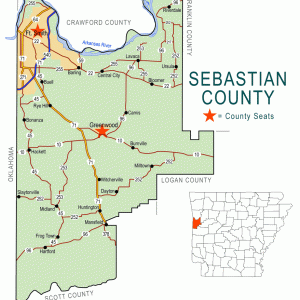calsfoundation@cals.org
Frog Town (Sebastian County)
Frog Town (sometimes rendered Frogtown) is an unincorporated community in southern Sebastian County. It is on State Highway 45 northeast of Hartford (Sebastian County). Frog Town is most noted for violent acts during the Sebastian County Union War of 1914.
The Arkansas River Valley and northern Ouachita Mountains have been inhabited for thousands of years. White settlement in the region after Arkansas became a state was sparse, although roughly seventeen families were living between Sugar Loaf Mountain and the Poteau Mountains when Sebastian County was created in 1851. John Tumblin and Thomas Lewis both acquired land patents in the vicinity of Frog Town in 1860. Population increased rapidly beginning in the 1870s with the development of coal mining in the area. Frog Town, located about one mile from Prairie Creek Mine No. 4, was one of many settlements created for miners and their families.
Researcher Carolyn Sue Satterfield Poor found that the name Frog Town was given to the settlement because of the abundance of frogs in the area. The settlement never acquired a post office or a school; children of the miners probably attended school in Hartford. Mining in the area flourished into the 1940s, although the availability of natural gas and petroleum reduced the demand for coal beginning in the 1920s.
In 1914, the Mammoth Vein Coal Mining Company announced that Prairie Creek Mine No. 4 would become an open shop that summer, leading to opposition from the United Mine Workers of America, a labor union well represented in southern Sebastian County. Various acts of violence took place in the mines and mining towns that year. Gunshots were fired into miners’ homes in Frog Town on the night of July 12 and again on July 15. There were no injuries or fatalities, and the shooting was probably an act of terrorism, although the responsible parties were never apprehended. A pitched battle between unionized miners and company guards at Mine No. 4 on July 17 killed two employees and destroyed the mine. Legal action over the union war stretched into 1927, when the case was settled out of court.
In the twenty-first century, Frog Town is still a residential community. Because of easy access to larger towns and cities, no businesses exist in Frog Town. Two historic churches have existed in the vicinity of Frog Town. James Fork Church was named after a nearby river that begins in the Ouachita Mountains and enters the Poteau River in Oklahoma. The other church was called Shiloh Church. Both congregations later became inactive.
For additional information:
Poor, Carolyn Sue Satterfield. “Community Name Origins in West-Central Arkansas: A Study of Logan, Scott, Sebastian, Yell, and Southern Franklin Counties.” PhD diss., Oklahoma State University, 1986.
Sizer, Samuel A. “This is Union Man’s Country” Sebastian County 1914.” Arkansas Historical Quarterly 27 (Winter 1968): 306–329.
Steven Teske
Butler Center for Arkansas Studies
 Sebastian County Map
Sebastian County Map 




Comments
No comments on this entry yet.